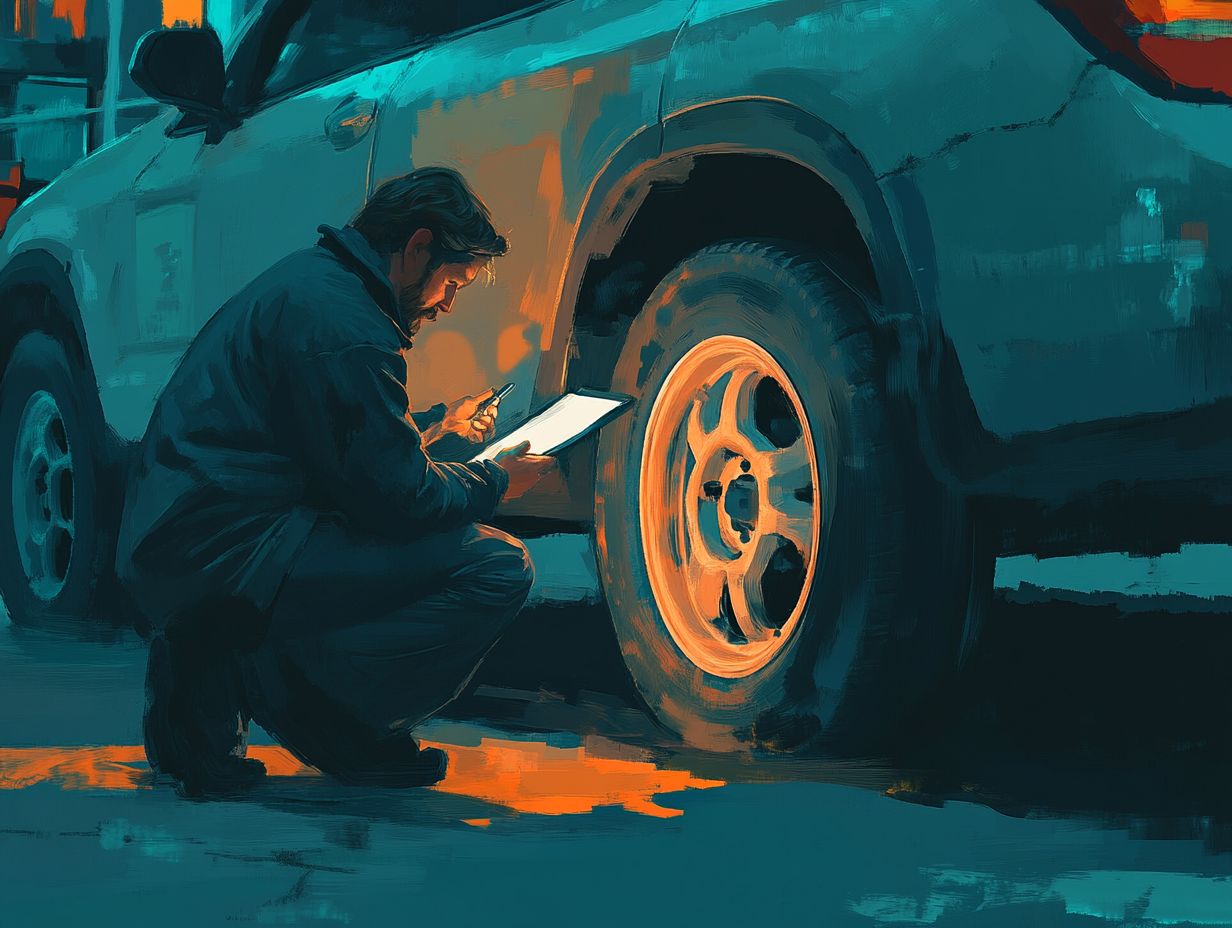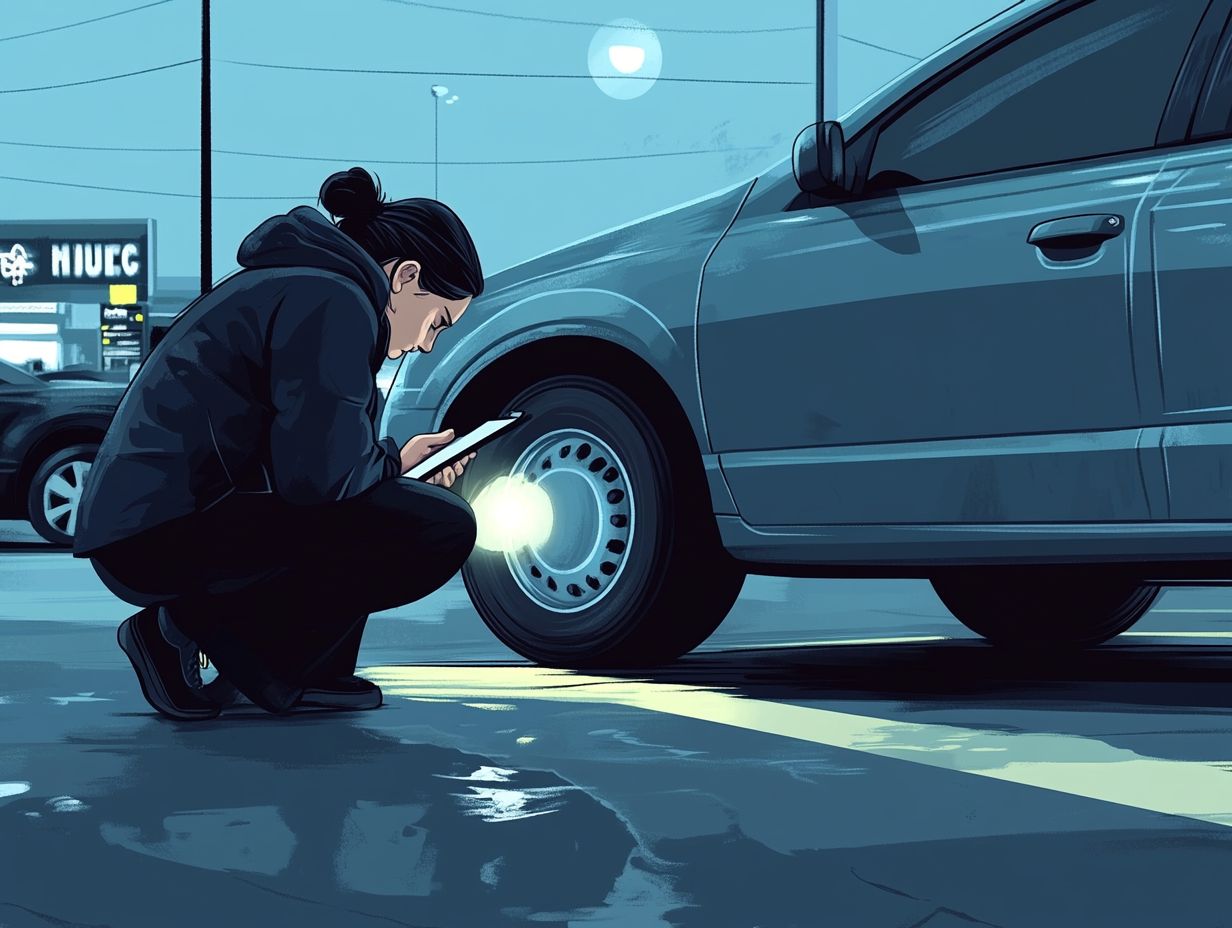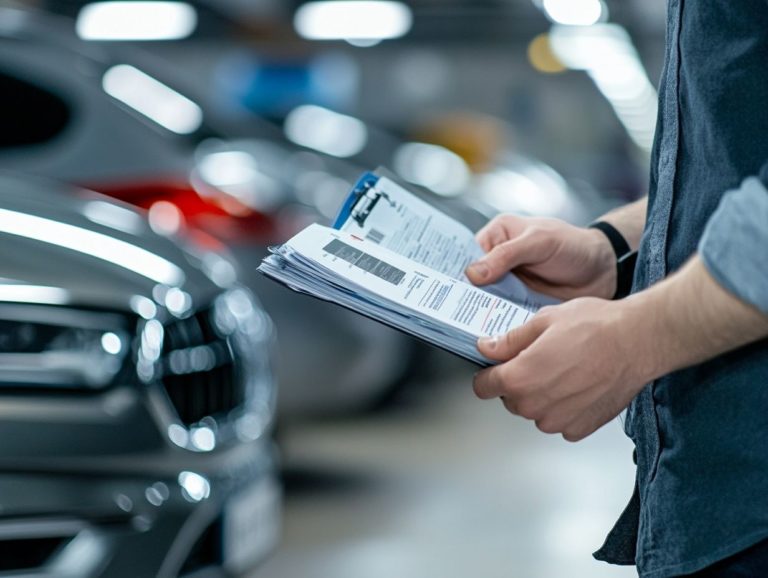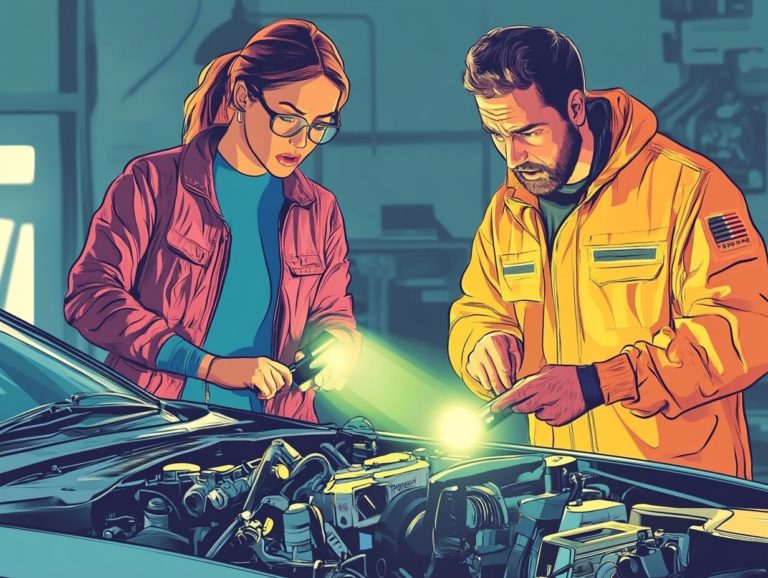How to Evaluate a Used Car’s Condition
Ready to dive into the world of used cars? Understanding a vehicle’s condition is your best defense against costly surprises! Whether you re in the market for buying or selling a used car, knowing its condition is absolutely essential. A thorough evaluation allows you to steer clear of costly surprises and empowers you to set realistic prices if you’re the seller.
From examining the exterior and interior to assessing the mechanical components, every step is crucial in ensuring a fair transaction.
This guide will walk you through the key aspects of evaluating a used car s condition, offering valuable tips for a successful test drive and highlighting the importance of a vehicle history report.
Whether you re on the hunt for your next car or preparing to sell, knowing exactly what to look for can truly make all the difference.
Contents
- Key Takeaways:
- Importance of Evaluating a Used Car’s Condition
- Exterior Inspection
- Checking for Rust and Damage
- Interior Inspection
- Mechanical Inspection
- Test Driving the Car
- Obtaining a Vehicle History Report
- Frequently Asked Questions
- What critical signs should I watch for while evaluating a used car?
- Is it important to check the vehicle’s service history?
- What are some common red flags to look for when evaluating a used car’s condition?
- Should I take a test drive before purchasing a used car?
- Is it necessary to have a mechanic inspect the used car before buying it?
- What documents should I ask for when evaluating a used car’s condition?
Key Takeaways:

- Properly evaluating a used car’s condition is crucial for both buyers and sellers.
- An exterior inspection should include checking for body and paint damage, as well as rust or other issues.
- When examining the interior, pay close attention to upholstery, features, and electronics, as well as testing the car’s controls.
Importance of Evaluating a Used Car’s Condition
Evaluating the condition of a used car is crucial, whether you’re a discerning buyer or a private seller looking to facilitate a smooth transaction. Understanding how to prepare for buying a used car, including details like its history, any past accidents, and warranty information, can profoundly influence price negotiations and overall buyer satisfaction.
Following established guidelines like the Federal Trade Commission s Buyers Guide helps both parties navigate the used car market effectively. This approach not only fosters a fair sale but also ensures compliance with local lemon laws laws that protect buyers from cars with significant defects and vehicle regulations.
Why it Matters for Buyers and Sellers
In the used car market, understanding the importance of evaluating a vehicle s condition is essential for both buyers and sellers to ensure a successful transaction. Accurate vehicle history and accident reports significantly shape perceptions and influence negotiations.
As a buyer, you want to feel confident that you re making a wise investment, while as a seller, presenting your car in the best possible light is key to maximizing your sale price. A good buyer’s guide helps both sellers and buyers understand what to look for, offering valuable insights for both private sellers and dealers.
These resources not only clarify the vehicle’s background but also equip you with data-driven arguments to support your pricing during discussions, paving the way for more informed and satisfactory agreements.
Exterior Inspection
When you assess a used car, starting with an exterior inspection is crucial for evaluating its overall condition. This initial step reveals valuable insights into the vehicle’s maintenance history and potential issues like rust and damage, helping you understand what to expect during a used car inspection.
By scrutinizing the body and paint, you can uncover signs of previous accidents and the quality of any repairs made. Additionally, a comprehensive inspection report can offer you peace of mind regarding the vehicle’s history, guiding you toward a more informed purchase decision.
Assessing Body and Paint Condition
Assessing the body and paint condition of a used car is essential, as it provides valuable insights into the vehicle’s maintenance history and potential mechanical issues. Additionally, understanding the importance of test driving a used car can further enhance your buying decision.
Your thorough inspection should begin with a meticulous examination of the exterior, focusing on the body panels and paint surface. Look for clues like scratches, dents, or uneven paint, all of which might hint at previous repairs or inadequate maintenance.
Keep an eye out for rust spots and bubbling paint these could signal underlying decay that may compromise the car’s structural integrity. It s equally important to assess alignment; uneven gaps between doors and panels can indicate frame damage. By regularly inspecting these details, you can identify potential problems that may lead to costly repairs in the future.
Now that you’re equipped with these tips, take the leap and evaluate your next used car with confidence!
Checking for Rust and Damage

Checking for rust and damage during an exterior inspection is vital for your peace of mind!
Pay particular attention to areas that demand close scrutiny, like the wheel wells, undercarriage, and edges of the doors. These spots are notorious for moisture accumulation and can signal deeper structural issues.
Even a hint of rust can compromise the vehicle’s integrity, leading to potentially costly repairs in the future and significantly reducing its resale value.
You should also document your findings in an inspection report. This helps potential buyers make informed decisions, enhancing transparency and trust throughout the sales process.
Interior Inspection
Ready to dive into a used car inspection? Conducting a thorough interior inspection is essential when considering a used car.
This careful examination provides valuable insights into the vehicle’s overall care and functionality.
Pay close attention to key aspects such as upholstery, vehicle features, and electronics, as they can indicate how well the car has been maintained.
Examining Upholstery and Features
Examining the upholstery and features of a used car offers you invaluable insights into its overall condition, and understanding how to use online reviews for used cars can further enhance your evaluation process.
By meticulously inspecting the fabric and materials for any signs of wear think frays, stains, or fading you can gauge how the previous owner treated the car.
Assessing crucial components like the dashboard, controls, and electronic features can reveal their maintenance habits. If a vehicle shows signs of neglect in these areas, it likely hasn t received the best care overall.
Understanding the condition of both the upholstery and essential features helps you make an informed decision, ultimately leading to a better investment and a more satisfying ownership experience.
Testing Electronics and Controls
Testing the electronics and controls within a used car is a crucial part of the interior inspection process.
As you evaluate the vehicle, assess various features, including the audio system, climate control settings, and dashboard indicators.
Each of these components significantly contributes to your overall driving experience.
A functioning audio system not only elevates your enjoyment on the road but also signals that the vehicle has been well cared for.
By checking the responsiveness of the climate controls, you can gain valuable insights into the maintenance of the vehicle s heating and cooling system.
In a well-maintained vehicle, you’ll typically find smooth functionality across all electronic features, suggesting that previous owners prioritized upkeep and promptly addressed any issues.
Mechanical Inspection
A thorough mechanical inspection is vital for assessing the integrity of a used car.
It emphasizes critical components such as the engine, transmission, brakes, suspension, and steering, ensuring that you make a confident choice before your purchase.
Checking Engine, Transmission, and Brakes

Checking the engine, transmission, and brakes during a mechanical inspection is essential for gauging a used car’s performance and safety.
These components serve as the lifeblood of any vehicle, and any signs of wear or malfunction can indicate deeper issues that might jeopardize its reliability.
For example, if the engine produces unusual noises or exhibits leaks, it may signal underlying mechanical problems that could lead to expensive repairs.
Likewise, a transmission that struggles with shifting can impact overall drivability, and brakes that wear unevenly can create serious safety risks.
By meticulously evaluating these critical parts, you can gain invaluable insights into the vehicle’s condition and longevity, which is essential when learning how to research a used car model, helping you make a more informed decision as a potential buyer.
Evaluating Suspension and Steering
Evaluating the suspension and steering of a used car is essential for ensuring the vehicle’s handling and ride quality meet your expectations.
A thorough assessment of these systems can uncover critical insights about the vehicle’s longevity and performance. It s vital to inspect components like the shocks and struts for any signs of wear or leaks. Check the control arms and bushings for damage or looseness.
When examining the steering system, pay close attention to unusual noises or play in the steering wheel; these can indicate underlying issues that might compromise your safety.
Observe how the car absorbs bumps and responds to your steering inputs. This evaluation significantly influences your driving comfort and control. Don’t skip this vital step in your car-buying adventure!
Test Driving the Car
Test driving the car is a crucial step in evaluating a used vehicle. This experience enables you to assess the performance and handling firsthand, helping you uncover any issues that might remain hidden during static inspections.
Engaging in a test drive allows you to truly connect with the vehicle and make an informed decision.
What to Look for During a Test Drive
During your test drive, pay close attention to the vehicle s performance and handling, assessing how it responds to various driving conditions.
Start by evaluating acceleration watch how quickly the vehicle picks up speed from a standstill or when merging onto highways. Next, listen for the braking sound; a smooth, quiet stop is a sign of good brake health. Any grinding or squeaking should definitely raise red flags.
Steering responsiveness can tell you a lot about the vehicle s agility. Does it feel direct and precise, or is there a disconnect that could affect handling? By focusing on these elements, you ll gain a clearer picture of the car’s overall capabilities and how well it suits your needs.
Obtaining a Vehicle History Report
Acquiring a vehicle history report is crucial when purchasing a used car. This report offers a wealth of information, detailing the vehicle s accident history, service records, and overall condition, all tied to its unique Vehicle Identification Number (VIN).
How to Get a Comprehensive Report

To obtain a comprehensive vehicle history report, provide the VIN and select a reputable service that specializes in used cars. The Vehicle Identification Number (VIN) serves as a unique fingerprint for the car, ensuring that all the information you retrieve is tailored specifically to that vehicle.
Once you’ve chosen a trustworthy source like Carfax or AutoCheck simply enter the VIN to access detailed records. Scrutinize elements such as accident history, title status, previous ownership, and any mileage discrepancies. These factors can greatly affect the vehicle’s value and reliability. Service records provide valuable insights into the vehicle’s maintenance history.
Frequently Asked Questions
What critical signs should I watch for while evaluating a used car?
When evaluating a used car’s condition, pay attention to the exterior, interior, engine, and overall functionality. Before making a decision, consider what to check before buying a used car to look for signs of damage, wear and tear, and potential mechanical issues.
Is it important to check the vehicle’s service history?
Yes, reviewing the car’s service history is crucial to understand how well it has been maintained. This can help identify any recurring issues or potential red flags.
What are some common red flags to look for when evaluating a used car’s condition?
Common red flags include rust, unusual noises from the engine, mismatched paint, and signs of major accidents or repairs. These can indicate potential costly problems in the future.
Should I take a test drive before purchasing a used car?
Absolutely. A test drive gives you a better feel for the car’s performance and handling, helping you detect any issues with the brakes, steering, or suspension.
Is it necessary to have a mechanic inspect the used car before buying it?
It’s a good idea to have a professional mechanic inspect the vehicle before buying. They can spot hidden issues and give you an unbiased assessment of the car’s condition. This inspection could save you from costly repairs down the road!
What documents should I ask for when evaluating a used car’s condition?
Don’t forget to ask for the car’s registration, title, and any service records. Also, request a vehicle history report to check for past accidents or flood damage.






